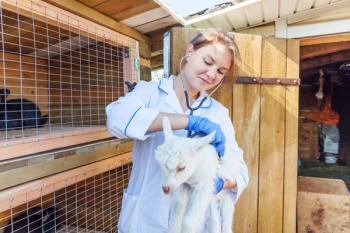
Tick Tidbits: Ticking Off the 5 W’s on These Tiny Troublemakers
Sponsored by Elanco
Five take-home messages
- There are more ticks in more places. Ticks are increasing in number and location. As ticks spread into new communities and neighborhoods, so too do their associated pathogens.
- Ticks pose a risk to animal and human health, mainly through the pathogens they transmit. In the US, ticks transmit a notable diverse array of bacterial, protozoal, and viral pathogens.
- “Tick season” is all year. In the continental US and Hawaii, ticks pose a year-round risk, including during traditional winter months. In many places, especially in the northern half of the US, tick season is longer now than in decades past.
- No vaccine options to protect against non–Lyme disease tick-borne pathogens. Although there are several commercial vaccines on the market to protect dogs from Lyme disease, there aren’t vaccines to protect dogs from other pathogens that ticks can transmit, including Anaplasma phagocytophilum, a tick-borne pathogen that is increasingly detected in dogs.
- The most comprehensive way to protect our dogs and other pets from ticks and reduce their risk of developing a tick-borne disease is by using a fast-acting tick control product.
Overview
Ticks pose an increasing health risk to people and pets, primarily as vectors of numerous bacterial, protozoal, and viral pathogens.1-2Importantly, many tick-borne pathogens that can infect and cause disease in dogs are zoonotic, meaning they can also infect and cause disease in humans. Because of the shared risk of encountering ticks, dogs are excellent sentinels for pet-owner tick encounter risk. Over the past several decades, the prevalence and incidence of many tick-borne diseases, including Lyme disease, anaplasmosis, and ehrlichiosis, have significantly increased. Several vaccines are marketed to protect dogs against Lyme disease; however, vaccines to protect people or pets against other tick-borne pathogens either do not exist or are not yet commercially available (several human Lyme disease vaccines are in clinical trial). In most areas of the US, ticks present a year-round threat; thus there is no true risk-free time of year as relates to ticks and tick-borne diseases. The expanding density and geographic distribution of several medically important tick species that bite pets and people further increase the risk of encountering ticks. As ticks move into new areas, the pathogens they carry also move into these new areas. Along with the intensifying and expanding range of domestic tick species, introduction and establishment of foreign tick species into the US presents an added an omnipresent threat, highlighted by the introduction of the longhorned tick, Haemaphysalis longicornis.3 In the absence of an arsenal of tick-borne pathogen vaccines, the most comprehensive strategy to protect pets against ticks and reduce their risk of developing a tick-borne disease is the year-round use of a fast-acting tick control product.
What are ticks?
Ticks are arachnids and belong to the same taxonomic class as spiders and scorpions. Morphologically, they have a fused head and body and possess 8 legs as nymphs and adults. Simple characteristics of the scutum (back plate) and mouthpart can be used to differentiate the tick species that commonly bite pets and people. Ticks are long-lived (2 to 3 years) and typically only feed 3 times in their life, once per life stage (larvae, nymph, and adult). The tick species that commonly bite pets and people typically rely on a variety of wildlife species (eg, rodents, birds, deer) to maintain local populations. Although ticks spend up to 2 weeks on a host when they are feeding, most of their life is spent off-host in the environment.
Where are ticks?
To survive, ticks require hosts and environments with suitable temperatures and humidity. Ticks can be found in areas with tall grass, tree canopy, or other vegetative ground cover. These types of environments help buffer temperature extremes, improve humidity, and provide habitat for the wildlife species that ticks most commonly use as hosts. Places where wildlife species are active are places where ticks are more likely to be found. A notable exception is the brown dog tick, Rhipicephalus sanguineus, which preferentially utilizes dogs as hosts for all life stages and prefers to live in sheltered environments (eg, homes, kennels). A list of ticks that commonly bite pets and people, as well as their general US geographic distributions, is provided (Table 14).
Table 1. Ticks Commonly Found in the US4
When are pets (and people) at risk for ticks?
Different tick species and different life stages of a given tick species can be active at different times of the year. However, for most of the US, tick season is now all year; this is because there is typically at least 1 tick species active at any given time of the year. Knowing what tick species are common to a given region and when they are active will inform when pets (and people) are at greatest risk of encountering a host-seeking tick and being infected with a tick-borne pathogen. Tick activity will vary by region, based on the tick species common to that area, the time of year, the likelihood of host activity, and local environmental factors such as temperature and humidity. In general, the risk of coming across a host-seeking tick is very low when the temperature is below 35 °F.5 During hotter periods, tick activity is likely to be greatest in shaded areas or during cooler times of the day. Ticks also prefer more humid areas, which they find by living in areas with vegetation or other protected habitats. Habitats and areas where wildlife species are active are often areas where ticks are more likely to be present.
Who is at risk for tick bites?
The tick species that most commonly bite pets and people (Table 1) typically utilize a diverse array of wildlife species as “normal” hosts. For the most part, pets and people are not important in the maintenance of local tick populations. The ticks in Table 1 are 3-host ticks, meaning they feed on a different individual host at each life stage. Frequently, as the tick progresses through its life stages, it feeds on progressively larger hosts. For example, larval ticks commonly feed on rodents and ground-feeding birds. Nymphs may parasitize a wide range of hosts of different sizes, anything from rodents to deer. Adults typically feed on larger mammals like deer and dogs. One notable exception is the brown dog tick, which prefers to feed on dogs at each life stage. However, brown dog ticks will still bite people and cats if given the opportunity.
Once a host is located, the tick will crawl to a favorable site on the host and attach using a combination of barbed mouthparts driven into the host’s skin and reinforced with glue-like salivary proteins. The attachment process can take up to 24 hours for an adult tick. The tick salivates a complex mixture of proteins to prepare the feeding site and hide from the host’s immune system, during which they may transmit pathogens. As most tick-borne pathogens are dispensed into the host via tick saliva, the longer the tick is attached and salivating into the host’s skin, the greater the risk for pathogen transmission. After the tick finishes feeding, it will detach from the host and fall back into the environment. The attachment and feeding process takes about 3 to 15 days, depending on the tick species and life stage. Once the tick detaches, it will either molt to the next life stage within a few weeks or, if it’s an adult female, she will find a protected place to lay her eggs (2000 to 4000 eggs).
Often, pet owners are unaware their pet has been infested with a tick because unfed ticks are small, and dogs don’t often give owners cues of being infested, such as itching or scratching. Because ticks are often and easily overlooked on dogs and the longer the tick is attached, the greater the risk of pathogen transmission, regular year-round use of a fast-acting tick control product is an ideal way to protect pets against ticks and reduce their risk of developing a tick-borne disease.
Why do we care about ticks?
We care about ticks because they 1) are nuisance pests, 2) can cause direct injury (eg, anemia, paralysis), 3) can initiate allergic conditions (eg, alpha-gal syndrome), and 4) can transmit pathogens. In the US, ticks are the most common arthropod vectors of pathogens for people and pets. Table 2 includes a list of the most common tick-borne pathogens reported in pets and people in the US and their associated tick species. For most of the listed pathogens, the tick initially acquires the pathogen from an infected wildlife host reservoir and then maintains that pathogen through the remainder of its individual life span, capable of transmitting the pathogen when feeding on its next host. Few of the listed pathogens are passed from the female tick to her progeny; notable exceptions include many of the viral pathogens and some Rickettsia species. An excellent resource of monitoring where pets and people are at greatest risk for 3 major tick-borne diseases—Lyme disease, anaplasmosis, and ehrlichiosis—is the Companion Animal Parasite Council.2 The Centers for Disease Control and Prevention (CDC) also has excellent information on the clinical signs and case incidence of tick-borne diseases for people.6 Because pets and people face similar risks of encountering ticks and contracting tick-borne pathogens, a pet testing positive for a tick-borne pathogen indicates it has been in an area with infected ticks—meaning the pet owner was also likely exposed to the same environment.7 Direct transmission of tick-borne pathogens between pets and people is exceedingly rare.
Table 2. Tick-Borne Diseases Most Commonly Reported in Dogs and Cats in the US
How can we protect our pets from ticks and reduce their risk of getting a tick-borne disease?
Below are strategies for protecting pets and people from ticks and reducing their risk of developing tick-borne diseases.
Avoid ticks: This is not always practical or feasible, especially because more ticks are now in more places.
Environmental control: The CDC outlines several strategies to reduce the risk of ticks on personal property.8 These include clearing tall grass and brush, frequent mowing, keeping playground and other outdoor activity items in sunny locations and away from unmanaged or dense vegetation, using environmental acaricides (chemical control), and restricting access to wildlife that are common tick hosts (eg, deer and mice).
Tick checks: If a pet or person has been in an area where ticks are known to be active, they should perform a thorough, whole-body tick check. On dogs, around the ears, eyes, under the legs, belly, under the collar, and around the tail should be checked. On people, around ears and hairline, waist, armpits, back of the knee, groin area, belly button, and back should be checked. If a tick is found, a pointy pair of tweezers can be used to remove the tick by grasping it as close to the skin as possible and pulling back with steady and even pressure. Afterward, one should wash or disinfect the bite site. The tick can also be saved for testing or evidence of a tick bite.
Additional tick control options for people: People should dress in light-colored, unpatterned clothing to help rapidly spot crawling ticks and should also treat clothing with acaricides (eg, permethrin sprays [CAUTION: do not use around cats]). Treat the skin with repellents (eg, DEET or picaridin).
Tick control products for pets: There are many effective and safe tick control products commercially available to protect pets from ticks and reduce their risk of developing a tick-borne disease. The 3 general categories for tick-control products are as follows:
Systemic-acting isoxazoline-containing products: Depending on the specific product, these products may be orally administered or topically applied. These products work systemically and provide excellent full-body coverage.
Topicals: These products (eg, permethrin or fipronil) are topically applied to the pet’s skin and are distributed over the pet’s skin through dermal translocation to provide protection.
Collars:Similar to topicals, the active ingredients in these products migrate into the pet’s skin and spread over the body to provide protection.
Note: Pet owners should consult with their veterinarian on tick control product choice. As with any drug, product labels should be thoughtfully reviewed and followed.
Because isoxazoline drugs are systemically distributed, the tick must start the biting process to be exposed to the drug. Therefore, if the tick must start the biting process, a common expectation from veterinarians and pet owners is that the drug should work fast to kill ticks to prevent or reduce the chance of tick-borne pathogen transmission. Many of the isoxazoline-containing products for dogs have similar label claims regarding the time to control the most common tick species, perhaps giving the impression that the various products “work” at a similar speed to each other. An important factor to consider when choosing a tick-control product is how quickly it kills ticks, as faster elimination reduces the risk of transmitting a tick-borne pathogen. Additionally, it’s essential to assess whether the product maintains its speed of action throughout the entire dosing period—for example, does it work as effectively at the end of the month as it does at the beginning?
Recently, we completed a study comparing the speed of tick kill for dogs treated with 1 of 3 commercially available, monthly-use tick-control products containing different isoxazoline drugs: lotilaner (Credelio), sarolaner (Simparica Trio), and afoxolaner (NexGard).9 In this study, dogs were experimentally infested with Amblyomma americanum (Lone Star tick), a challenging tick for many tick-control products. The speed of each of these products to control A americanum infestations was compared among treatment groups.
The major conclusions of this study were as follows:
- For only lotilaner-treated dogs, significant A americanum control began by 12 hours post treatment and post reinfestation on days 21 and 28 post treatment.
- Only lotilaner-treated dogs achieved over 90% tick control by 24 hours post treatment and post reinfestation on days 21 and 28 post treatment.
- At no point was the efficacy of the sarolaner combination product or afoxolaner significantly greater than lotilaner.
- For new infestations during the second half of the month (day 21 and 28 post treatment) the time to over 90% tick control was achieved 24 to 48 hours earlier for the lotilaner group compared to the sarolaner combination product or afoxolaner groups.
- Only lotilaner worked as fast at the end of the month as it did at the beginning of the month.
The speed of tick kill with these systemically acting drugs is imperative because the tick must start the biting process to acquire the drug and die. The longer a drug takes to kill ticks, the greater the risk of pathogen transmission. The speed of tick-borne pathogen transmission varies among pathogens. For Borrelia burgdorferi, the agent of Lyme disease, based on controlled transmission timing studies in the US, transmission began after 24 hours of infestation. Between 24 to 48 hours from infestation, approximately 10% of hosts were infected. Between 48 to 72 hours, approximately 70% of hosts were infected. However, for Anaplasma phagocytophilum, the agent of anaplasmosis, transmission may occur more quickly (between 16 and 24 hours from infestation). No studies are available on the transmission speed of US-sourced Ehrlichia canis, but data from Europe suggests transmission may occur within 3 to 6 hours.10
The bottom line is that the more quickly ticks are killed, the less likely pathogens will be transmitted.
References:
- Ticks. Centers for Disease Control and Prevention. Accessed February 16, 2025.
https://www.cdc.gov/ticks/index.html - Companion Animal Parasite Council. Accessed February 16, 2025.
https://capcvet.org/ - The Asian longhorned tick: what you need to know and what you can do. USDA Animal and Plant Health Inspection Service. Accessed February 16, 2025.
https://www.aphis.usda.gov/aphis/maps/animal-health/asian-longhorned-tick - Regions where ticks live. Centers for Disease Control and Prevention. December 18, 2024. Accessed February 16, 2025.
https://www.cdc.gov/ticks/geographic_distribution.html - Clark DD. Lower temperature limits for actively of several Ixodid ticks (Acari: Ixodidae): effects of body size and rate of temperature change. J Med Entomol. 1995;32(4):449-452. doi:10.1093/jmedent/32.4.449
- Tickborne diseases of the United States. Centers for Disease Control and Prevention. Updated March 10, 2025. Accessed February 16, 2025.
https://www.cdc.gov/ticks/tickbornediseases/index.html - Liu Y, Nordone SK, Yabsley MJ, Lund RB, McMahan CS, Gettings JR. Quantifying the relationship between human Lyme disease and Borrelia burgdorferi exposure in domestic dogs. Geospat Health. 2019;14(1):111-120. doi:10.4081/gh.2019.750
- Preventing tick bites. Centers for Disease Control and Prevention. August 28, 2024. Accessed February 16, 2025. https://www.cdc.gov/ticks/prevention/
- Reif KE, Kollasch TM, Neilson JC, et al. Comparative speed of kill provided by lotilaner (Credelio), sarolaner (Simparica Trio), and afoxolaner (NexGard) to control Amblyomma americanum infestations on dogs. Parasit Vectors. 2024;17(1):313. doi:10.1186/s13071-024-06363-w
- Fourie JJ, Stanneck D, Luus HG, Beugnet F, Wijnveld M, Jongejan F. Transmission of Ehrlichia canis by Rhipicephalus sanguineus ticks feeding on dogs and on artificial membranes. Vet Parasitol. 2013;197(3-4):595-603. doi:10.1016/j.vetpar.2013.07.026
Newsletter
From exam room tips to practice management insights, get trusted veterinary news delivered straight to your inbox—subscribe to dvm360.




